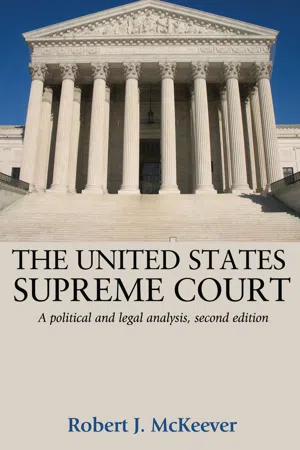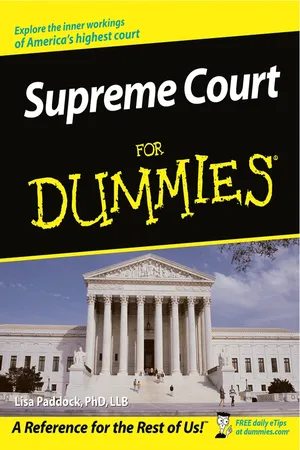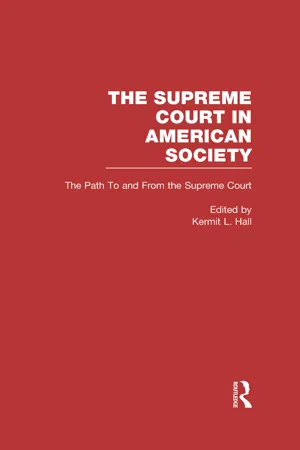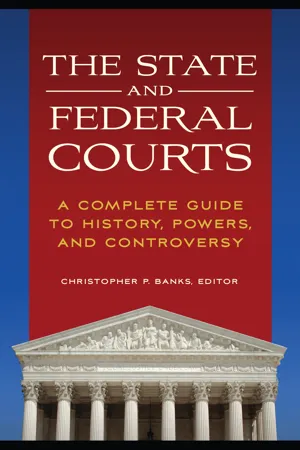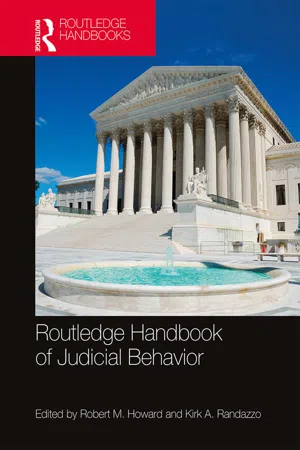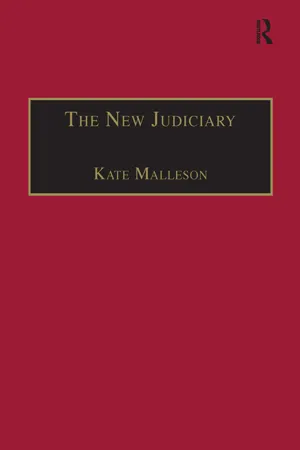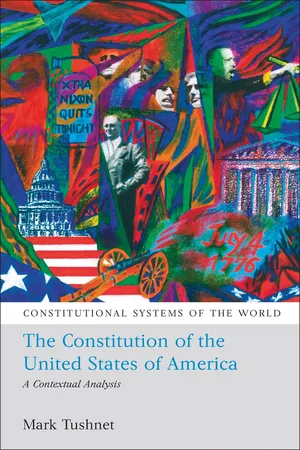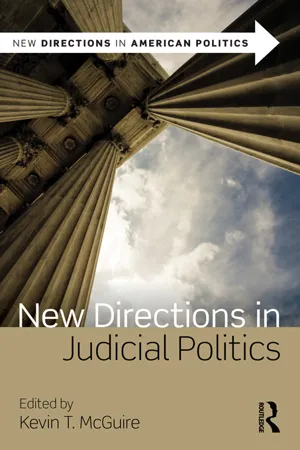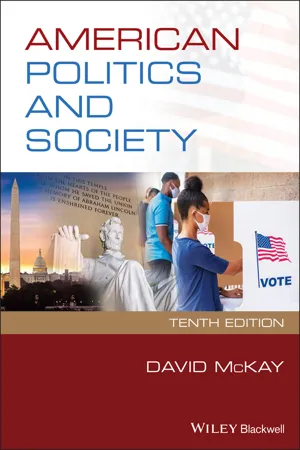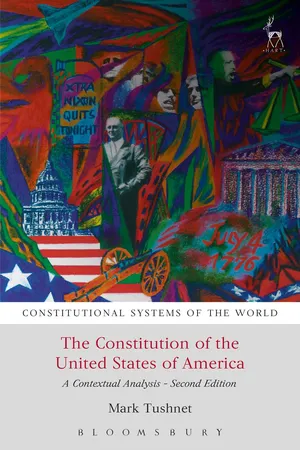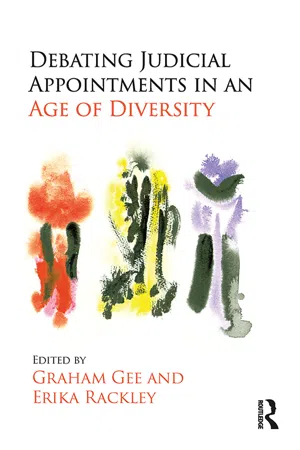Politics & International Relations
Supreme Court Appointment Process
The Supreme Court appointment process refers to the procedure for nominating and confirming justices to the highest court in the United States. The President nominates a candidate, who then undergoes a confirmation process in the Senate. This process is highly political and can have significant implications for the ideological balance of the Court.
Written by Perlego with AI-assistance
Related key terms
12 Key excerpts on "Supreme Court Appointment Process"
- eBook - ePub
The United States Supreme Court
A political and legal analysis, second edition
- Robert J. McKeever(Author)
- 2016(Publication Date)
- Manchester University Press(Publisher)
5 Advice and consent: the politics of Supreme Court appointments In this chapter we analyse one of the most controversial aspects of the modern Supreme Court: the process of appointing new Justices. Among other things, we will explore such questions as who becomes a Supreme Court Justice and why? Who influences the selection of the Justices and how? And what effect does the selection process have upon the subsequent behaviour of the Justice once seated upon the Court? In short, we shall examine the power and politics of Supreme Court appointments. The constitutional framework The broad framework for the appointment of Supreme Court Justices is delineated in Article II, Section 2 of the Constitution. This states that the President ‘shall nominate, and by and with the Advice and Consent of the Senate, shall appoint … Judges of the Supreme Court’. Like most constitutional clauses, Article II, Section 2 is open to varied and even conflicting interpretation, as we shall see shortly. Yet certain things are clear. First, it is important to note that there are two distinct phases of the process: nomination and confirmation. Nomination involves proposing someone for a seat on the Court, whereas confirmation entails approving or rejecting that nominee as a Justice of the Supreme Court. Second, two institutions of the federal government are given a role in the process: the President and the Senate. Their roles, however, are different. The President has sole power over the nomination process, but the Senate has sole power over the confirmation process. In practice, this means that the President sends the name of a candidate for the Court to the Senate, and the Senate then decides whether to confirm or reject the President’s nominee. If the nominee is confirmed, then he or she takes up the vacant seat on the Court - eBook - ePub
- Lisa Paddock(Author)
- 2011(Publication Date)
- For Dummies(Publisher)
Chapter 4
Make No Mistake, These Justices Are Politicians: The Confirmation Contest
In This Chapter
Understanding how Supreme Court justices are chosenDemystifying the job requirementsLooking at the confirmation processExamining some problem candidatesComparing confirmations of associate and chief justicesS upreme Court justiceships are lifetime appointments. Is it any wonder that the process of nominating and confirming these powerful people can be hard-fought, even theatrical? In this chapter, I walk you through the process of selecting and confirming Supreme Court justices and examine the political and professional considerations involved. Then I look closely at some candidates who survived and some who didn’t.The Selection Process: A Mixed Bag
The Constitution offers precious little guidance about selecting a Supreme Court nominee. Like so many other aspects of the law, High Court appointments are largely a matter of precedent and tradition. Still, the consequences of putting someone on the bench of an institution that is free to make laws without having to answer to an electorate — or even to the president responsible for putting that person on the Court — are enormous. It’s the politics of the appointment process that make it the most intricate, most closely watched chess game around.Justices without a legal education?
Theoretically, it is possible for nonlawyers to become Supreme Court justices, although this possibility has never happened. The Founding Fathers may simply not have thought to mention legal education as a prerequisite for the job. When they drafted the Constitution, there were — not surprisingly — no law schools in the new nation. The first American law school was established by Tapping Reeve in Litchfield, Connecticut, in 1784. However, for decades after the foundation of the republic, lawyers became lawyers by “reading law” — that is, apprenticing themselves to practicing lawyers. It is still possible to be admitted to some state bars without having graduated from law school. - eBook - ePub
The Path to and From the Supreme Court
The Supreme Court in American Society
- Kermit L. Hall(Author)
- 2018(Publication Date)
- Routledge(Publisher)
EV . 633, 643–44 (1987).5 Although several recent nominations to the Court have received more scrutiny than did most nominations before the Reagan-Bush era, many earlier nominations also attracted considerable controversy. See HENRY J. ABRAHAM , JUSTICES AND PRESIDENTS : A POLITICAL HISTORY OF APPOINTMENTS TO THE SUPREME COURT (3d ed. 1992).6 Professor Silverstein recently has pointed out that the transformation of the Senate during the past few decades into “a more open and effective forum for the expression of diverse interests” has increased “the likelihood of contentious battles over any Presidential nomination.” Mark Silverstein, The People, the Senate and the Court: The Democratization of the Judicial Confirmation System , 9 CONST . COMMENT . 41, 52 (1992). As Silverstein has observed:The apparent decorum of the past was achieved at the expense of participation and accountability. Few who viewed the agony and personal tragedies of the Clarence Thomas proceedings can avoid the almost instinctive desire to return to less visible and contentious proceedings, but the stakes are too high and involve the vital interests of too many forces to seek refuge in the ways of the past.Id. at 58.7 As Senator Simon pointed out, “examination of the base from which justices emerge is essential because of the Court’s immeasurable impact upon the future of the nation.” Paul Simon, The Exercise of Advice and Consent , 76 JUDICATURE 189 (Dec. 1992-Jan. 1993). Similarly, Professor Eades wrote:The nature of the judiciary itself may be the strongest reason for substantial review of judicial nominees. The federal judiciary, especially the United States Supreme Court, holds a unique position in our form of government. The power of any one legislator is diluted by the fact that there are so many of them. The power of the executive is filtered through the political process which requires that the President receive the approval of numerous people before being placed into office. The members of the judiciary have neither of these criteria for authority. One Supreme Court Justice, on a closely divided Court, however, can hold great power. - eBook - ePub
The State and Federal Courts
A Complete Guide to History, Powers, and Controversy
- Christopher P. Banks, Christopher P. Banks(Authors)
- 2017(Publication Date)
- ABC-CLIO(Publisher)
Justices, Presidents, and Senators: A History of U.S. Supreme Court Appointments from Washington to Bush II . 5th ed. Lanham, MD: Rowman & Littlefield.Batta, Anna, Paul M. Collins, Jr., Tom Miles, and Lorie A. Ringhand. 2012. “Let’s Talk: Judicial Decisions at Supreme Court Confirmation Hearings.” Judicature 96(1): 7–15.Collins, Paul M., Jr., and Lori A. Ringhand. 2013. Supreme Court Confirmation Hearings and Constitutional Change . New York: Cambridge University Press.Maltese, John Anthony. 1995. The Selling of Supreme Court Nominees . Baltimore: The Johns Hopkins University Press.Ringhand, Lori A., and Collins, Paul M., Jr. 2011. “May it Please the Senate: An Empirical Analysis of the Senate Judiciary Committee Hearings of Supreme Court Nominees, 1939–2009.” American University Law Review 60(3): 590–641.Wedeking, Justin, and Dion Farganis. 2010. “The Candor Factor: Does Nominee Evasiveness Affect Judiciary Committee Support for Supreme Court Nominees?” Hofstra Law Review 39: 329–368.Wittes, Benjamin. 2006. Confirmation Wars: Preserving Independent Courts in Angry Times . Lanham, MD: Roman and Littlefield.Yalof, David A. 1999. Pursuit of Justices: Presidential Politics and the Selection of Supreme Court Nominees . Chicago: The University of Chicago Press.Yalof, David A. 2008. “Confirmation Obfuscation: Supreme Court Confirmation Politics in a Conservative Era.” Studies in Law, Politics, and Society 44: 141–171.IMPEACHMENT AND REMOVAL OF FEDERAL JUDGESImpeachment is a process for removing from office top government officials and judges. For federal officials and judges, the impeachment process is defined in the U.S. Constitution in Article II, Section 4, and in Article III. For state governors, top officials, and judges, the impeachment process is spelled out in state constitutions and statutes. Impeachment is a process, which means several constitutionally mandated steps must be followed in sequence in order to remove the officeholder. - eBook - ePub
- Robert M. Howard, Kirk A. Randazzo(Authors)
- 2017(Publication Date)
- Routledge(Publisher)
The Supreme Court selection process is a high-profile event with much at stake for a variety of actors. Presidents put their reputations and legacies on the line since their nominees are almost assured to serve for decades after the presidents leave the White House. Senators are given the opportunity to provide a democratic check on president’s appointment authority, in addition to using the confirmation process in an attempt to increase their statures in the eyes of the public and their political parties. The lives of nominees are perhaps most dramatically affected, as they are thrust into the spotlight to undergo intense scrutiny from the public, the media, the White House, and the Senate. Outside of government, interest groups leverage the hearings to mobilize support for their causes, while trying to influence the outcome of the confirmation.Given the importance of Supreme Court selection, it should not be surprising that academics have devoted a substantial amount of attention to investigating this process. The purpose of this chapter is to critically examine the state of scholarship regarding the Supreme Court nomination and confirmation process. To do that, we follow the general temporal order of the process, focusing on its three major aspects: nomination by the president, the Senate Judiciary Committee hearings, and the confirmation vote by the full Senate. In addition to reviewing extant scholarship in those areas, we examine this research for the purpose of shedding light on the theoretical and methodological limitations of that scholarship, while offering directions for future research on this important subject.Presidential Nominations
When a vacancy opens on the Supreme Court,1 the president is charged with nominating a new justice under Article II, §2, cl. 2 of the Constitution (the “Appointments Clause”). Though the president alone holds that nomination power, the Senate is tasked with confirming presidential nominations under its authority to provide its “advice and consent.”2 In the event that the Senate is unavailable for deliberation, the president is authorized to make recess appointments under Article II, §2, cl. 3. These recess appointments do not require Senate approval and expire at the end of the following congressional session, which usually last about two years. Although the recess appointment process is seldom used—the last justice to initially reach the Supreme Court through a recess appointment was Potter Stewart in 1958—the power continues to generate debate (e.g., National Labor Relations Board v. Noel Canning - eBook - ePub
The New Judiciary
The Effects of Expansion and Activism
- Kate Malleson(Author)
- 2016(Publication Date)
- Routledge(Publisher)
4 AppointmentsOf the three areas examined in this work it is the appointments process which has been subject to the greatest pressure for change as a result of the effects of expansion and the growth of judicial activism. The increase in the numbers of judges has meant that the informal appointments system which could operate when the judiciary was a small institution in which the Lord Chancellor knew personally or by reputation every appointee has become unworkable. By necessity, it has had to be replaced by a more professional and structured process. At the same time, the growth in judicial power has drawn public attention to the political importance of the appointments process. As the functions of the judiciary have moved closer to those of the other branches of government claims that there should be more similarity in their selection methods have grown stronger (Bell, 1983, p. 269). Recent constitutional reforms designed to increase the representativeness of the political process, such as Scottish and Welsh devolution and restructuring of the House of Lords, have further highlighted the undemocratic nature of the judicial appointments process. The incorporation of the European Convention on Human Rights adds a new dimension to this process. The expectation that judges will shortly be called upon to decide on a range of social and political questions previously outside their remit has turned people’s attention to the question of who judges are and how they are appointed. In 1997, when Lord Irvine gave evidence before the Home Affairs Select Committee on the work of his department, he stated that there was no work to which he devoted more attention than the ‘vexed question’ of judicial appointments.1In the light of these developments, the need to increase openness and accountability in the appointments process, whilst at the same time maintaining a high degree of judicial independence has been the driving forces behind a number of recent changes to the system. The experience of many other common law countries including the US, Canada, South Africa, New Zealand and Australia as well as the civil law jurisdictions in continental Europe, suggests that as the power of the judges grows the pressure for structural change to the appointments process increases (East, 1995). In addition, the growing policy-making role of the judiciary raises questions about the selection criteria which should be applied in order to identify judicial candidates who are fitted for their new and more diverse roles. When the Home Affairs Select Committee examined the judicial appointments process in 1996 it acknowledged this need: ‘The kind of judges that are chosen in future will have to reflect the new role which society expects the judicial system to play’2 - eBook - ePub
The Constitution of the United States of America
A Contextual Analysis
- Mark Tushnet(Author)
- 2008(Publication Date)
- Hart Publishing(Publisher)
The politics associated with Supreme Court nominations typically mirrors the way politics is being conducted elsewhere. For long periods of US history, Supreme Court nominations were patronage appointments. A president would reward a political supporter or seek to secure continuing loyalty by nominating him or his preferred candidate. Some nominations were a different kind of patronage—appointments of the president’s personal friends and advisers. Demographic and geographic representation in nominations was the form that interest-group politics took in the appointment process.All these versions of politics continue to play a role. In 2008, for example, there was widespread agreement that the next Supreme Court nomination should probably go to a person of Hispanic origin, and if possible a woman, because the Hispanic electorate had become important politically and because Justice O’Connor’s departure left ‘only’ one woman on the Court. But, in the last decades of the twentieth century another form of appointment politics became increasingly important. Political scientist David Alistair Yalof calls the new process ‘criterion-driven’.10 Anticipating a Supreme Court vacancy, the White House and the Department of Justice develop criteria that they will seek to satisfy when the possibility of a nomination materializes. Some of these criteria have been representational, as when President Richard Nixon looked for a Southerner to appoint to the Court. More important, though, have been two other criteria. The first is age. Presidents, particularly reconstructive ones, sometimes see the Supreme Court as one vehicle for preserving their legacy. To do so, though, they incline to appointing relatively young justices, who will maintain the president’s perspective for what the president anticipates will be a long tenure.11Even more important has been an increase in attention to the criterion of judicial philosophy or ideology, particularly on the part of Republican presidents. Their concern has been that dismantling the New Deal’s constitutional legacy and constructing a new conservative constitutional order, tasks that they pursued in the executive branch and in Congress, also required dismantling the Warren Court and reconstructing it in a new image. Reconstruction, that is, required attention to what potential nominees would do if appointed to the Supreme Court. Not surprisingly, then, nominations by Republicans since the 1960s have been more criterion-driven than nominations by Democrats. That criterion-driven appointments matter was dramatically shown in 2006–07, the first year in which new justices John Roberts and Samuel Alito served on the Court. They joined holdover conservative justices in sharply revising constitutional law in thee areas—abortion, campaign finance, and affirmative action—where Justice O’Connor had cast the deciding vote with the Court’s more liberal members.12 - eBook - ePub
- Kevin T. McGuire, Kevin T. McGuire(Authors)
- 2012(Publication Date)
- Routledge(Publisher)
If this happened a lot, the appointment process, for all the attention it generates, would give departing justices the ability to help craft the Court. This has led some legal scholars to propose 18-year fixed terms for each justice; this would ensure a new appointee every two years so that every president elected to a full term would get at least two nominations (avoiding the situation of President Carter who did not make a single appointment to the Supreme Court in his four years in office). While this situation would defuse the kind of manipulation discussed above, it would also dramatically increase Court turnover, a potentially destabilizing development. And, Bailey and Yoon (2011) show in simulations that even if justices do try to time their retirements for political reasons, liberal and conservative justices more or less offset each other, meaning that the net effect of politically-timed retirements on the Court is modest.Once a seat opens up, the Court is at the center of one of its most public phases: the appointment process. Earlier chapters in this volume have gone into great detail on this process, so we focus largely on what the process means for the ability of elected branches to influence the Court. Political scientists Bryon Moraski and Charles Shipan (1999) offer a widely-used and incredibly useful framework for thinking about the process. They build on the observation of one of the great scholars of the appointment process, Henry Abraham, who concluded that “political and ideological compatibility has arguably been the controlling factor” behind nominations (1999, 3). Following standard models of the Supreme Court, they characterize the ideology of justices in terms of “ideal points” in policy space, which are numeric characterizations of the political preferences of justices. Some justices, such as Justices Breyer or Sotomayor, are liberal and have ideal points that are negative numbers (on the left if you draw them on a line); other justices, such as Justices Scalia and Thomas, are conservative and have ideal points that are positive numbers (on the right if you draw them on a line). The median justice can dominate the Court and get outcomes he or she wants because he or she can be the decisive vote for either the liberal or conservative outcome. In this view, if either side wants to win it must do what the median justice wants lest the other side gets there first. - eBook - ePub
- David McKay(Author)
- 2021(Publication Date)
- Wiley-Blackwell(Publisher)
CHAPTER 15 THE SUPREME COURT AND JUDICIAL POLITICSOutline- The American Legal System
- The Supreme Court:Decision-Making
- The Supreme Court and Political Power
- Controversy 15.1. The Supreme Court: An Active or a Passive Role?
- Briefing 15.1. The Supreme Court and the Guantánamo Bay Detainees
- The Polarized Rehnquist and Roberts Courts
- Conclusions: The Court and American Democracy
- Summary
- Questions for Discussion
- Glossary
- Notes
- Further Reading
We are very quiet there but it is the quiet of a storm centre.–OLIVER WENDELL HOLMES, ASSOCIATE JUSTICE OF THE SUPREME COURT, 1902–1932In a democracy, politics is a process of popular education – the task of adjusting the conflicting interests of diverse groups … and thereby to the hostility and suspicion and ignorance engendered by group interests … toward mutual understanding.– FELIX FRANKFURTER, ASSOCIATE JUSTICE OF THE SUPREME COURT, 1939–62In all societies, the courts play some political role. In liberal democracies, where the independence of the judiciary is regarded as essential to prevent the exercise of irresponsible executive (and sometimes legislative) power, the political role of the courts as interpreters of the law and as defenders of individual freedoms is well established. In despotic and one-party states, courts are political in the quite different sense that they are the instruments of a dominant executive. However, there are also important distinctions within liberal democratic states, the most crucial being the presence or absence of judicial review. As noted in Chapter 4 , judicial review is long established in the United States, the Supreme Court being the final arbiter of the meaning of the Constitution. Hence, all laws passed by the state and national legislatures, together with all executive actions, are subject to review by the courts, which judge their compatibility with the Constitution. As the final court of appeal, therefore, the Supreme Court has the legal power to declare any action by any other branch of government as unconstitutional. As we develop below, this apparently formidable power is tempered by a number of factors, but in contrast to many other liberal democracies, there can be no disputing the evidence of what is enormous potential judicial power. In the United Kingdom, for example, the courts can review executive actions – but only by testing them in relation to the content of Acts of Parliament. This can produce sharp rebukes for governments when the courts judge that the government has acted ultra vires or beyond its powers, and the British courts are becoming more active in reviewing executive actions. A British parliament controlled by the executive can, however, always reverse a judicial judgement, as sovereignty lies not in a constitution but in parliament (although, at least until 2020, in some matters the European Court of Justice did have the final say). In the United States, a decision of the Supreme Court involving the constitutionality of a statute or governmental action can be overturned only by constitutional amendment (or by the Court itself, of course) and, as shown in Chapter 3 - eBook - ePub
- David McKay(Author)
- 2017(Publication Date)
- Wiley-Blackwell(Publisher)
Chapter 15 The Supreme Court And Judicial PoliticsOutline
- The American Legal System
- The Supreme Court: Decision-Making
- The Supreme Court and Political Power
- Controversy 13. The Supreme Court: An Active or a Passive Role?
- Briefing: The Supreme Court and the Guantánamo Bay Detainees
- The Polarized Rehnquist and Roberts Courts
- Conclusions: The Court and American Democracy
- Summary
- Questions for Discussion
- Glossary
- Notes
- Further Reading
We are very quiet there but it is the quiet of a storm centre.– OLIVER WENDELL HOLMES, ASSOCIATE JUSTICE OF THE SUPREME COURT, 1902–32In a democracy, politics is a process of popular education – the task of adjusting the conflicting interests of diverse groups … and thereby to the hostility and suspicion and ignorance engendered by group interests … toward mutual understanding.– FELIX FRANKFURTER, ASSOCIATE JUSTICE OF THE SUPREME COURT, 1939–62In all societies, the courts play some political role. In liberal democracies, where the independence of the judiciary is regarded as essential to prevent the exercise of irresponsible executive (and sometimes legislative) power, the political role of the courts as interpreters of the law and as defenders of individual freedoms is well established. In despotic and one-party states, courts are political in the quite different sense that they are the instruments of a dominant executive. However, there are also important distinctions within liberal democratic states, the most crucial being the presence or absence of judicial review. As noted in chapter 4, judicial review is long established in the United States, the Supreme Court being the final arbiter of the meaning of the Constitution. Hence, all laws passed by the state and national legislatures, together with all executive actions, are subject to review by the courts, which judge their compatibility with the Constitution. As the final court of appeal, therefore, the Supreme Court has the legal power to declare any action by any other branch of government as unconstitutional. As we develop below, this apparently formidable power is tempered by a number of factors, but in contrast to many other liberal democracies, there can be no disputing the evidence of what is enormous potential judicial power. In the United Kingdom, for example, the courts can review executive actions – but only by testing them in relation to the content of Acts of Parliament. This can produce sharp rebukes for governments when the courts judge that the government has acted ultra vires - eBook - ePub
The Constitution of the United States of America
A Contextual Analysis
- Mark Tushnet(Author)
- 2015(Publication Date)
- Hart Publishing(Publisher)
27 In a period of unified government, as occurred under Roosevelt, nominations need not be strategic. The ordinary political considerations that a president takes into account will result in creating a Supreme Court whose members agree with the broad contours of the party controlling the other branches. Partisan entrenchment matters more when government is divided, and matters even more when a political regime is vulnerable and its adherents seek to salvage something of their constitutional vision by ensuring that the federal courts perpetuate that vision even after they have become a minority in the political branches. That was the Federalist strategy in 1800, and it may be the best description of the Republican strategy in the nominations of Chief Justice Roberts and Justice Alito.Politics, then, can help coordinate the judiciary with the other branches, but in some configurations politics can exacerbate rather than reduce conflict. Further, some of the mechanisms described here operate through politics, without judicial enforcement, yet probably are more accurately described as constitutional conventions that have normative force as politicians consider what they want to, can, and should do.DOCTRINAL CONSTRAINTS ON THE JURISDICTION OF THE FEDERAL COURTS
The Supreme Court has been sensitive to the countermajoritarian difficulty. It has developed some doctrines aimed at preserving what Justice Lewis F Powell called the ‘proper—and properly limited—role of the courts in a democratic society’.28 Gathered together under the general label ‘justiciability’ rules, these doctrines have been formally justified as flowing from the fact that judicial review in the United States is concrete and a posteriori. The Constitution gives the federal courts the power to decide ‘Cases or Controversies’. The Supreme Court has taken this to mean that the courts can decide constitutional questions only in the context of real controversies between parties whose legal and practical interests would be affected by a judicial resolution of those questions. These doctrines have a smaller scope than some of their formulations might suggest. Here we examine two—the political question doctrine and the standing doctrine—whose analysis exposes the ways in which the doctrines serve to coordinate actions by the three branches.29 - Graham Gee, Erika Rackley, Graham Gee, Erika Rackley(Authors)
- 2017(Publication Date)
- Routledge(Publisher)
Guarding the Guardians:[T]he legitimate exercise of power in the political sphere in a democratic society requires some degree of connection between the office holder in question and the public from whom that power is derived. As Lady Hale notes, the process of Supreme Court appointments ‘currently lacks any democratic accountability’87 – it involves no input whatsoever from the legislature, minimal input from the executive and actually requires no participant with a substantive role to be an elected office-holder. While undoubtedly crucial, judicial independence cannot be an absolute … Particularly in light of the new constitutional settlement, it is important to recognise that the appointment of senior judges is, in the broad sense, a political act. As such, it is ‘for the long-term health, quality and therefore standing and independence of the senior judiciary [that] there should also be an equal involvement of [the] other branches of government’.88 In the context of the expanded role and political significance of the judiciary, it is more important than ever to protect the legitimacy of this branch of government by ensuring that it is buttressed by a constitutionally appropriate appointments process. The current method of appointing our senior judiciary – and our Supreme Court Justices in particular – is, in short, not fit for purpose.89The response of many of the senior judiciary to such arguments is that there is no accountability or democratic deficit in their exercise of judicial power at the higher appellate levels. To those schooled in the seminal lecture by Lord Reid of Drem where he dismissed mechanical jurisprudence with a robust ‘we don’t believe in fairy tales anymore’90
Index pages curate the most relevant extracts from our library of academic textbooks. They’ve been created using an in-house natural language model (NLM), each adding context and meaning to key research topics.
